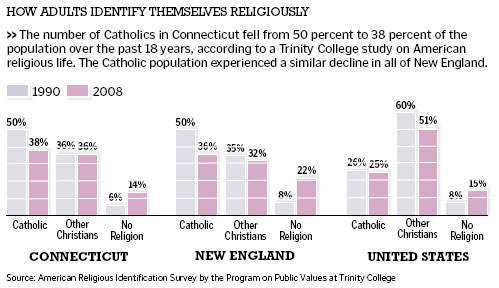By Jesse Leavenworth
Hartford Courant
March 10, 2009
http://www.courant.com/news/local/hc-religion0310.artmar10,0,890045.story
Since they began streaming into Connecticut in the mid-19th century, Roman Catholics have reshaped Yankee culture — influencing language, politics, food, architecture and the ethnic patchwork of cities and towns.
In the past 18 years, however, the percentage of state residents who identify themselves as Catholic has sunk — from 50 percent of the population in 1990 to 38 percent last year — according to a study released Monday by researchers at Trinity College.
The decline in Catholics was accompanied by an increase — from 6 percent to 14 percent — in the number of state residents who said they had no religion, according to the American Religious Identification Survey. The number of state respondents who said they belonged to other Christian branches remained steady at 36 percent.
 |
The national survey of 54,461 people found that the Roman Catholic population has been shifting from the Northeast to the Southwest; that the number of all Christians in the nation declined by 10 percentage points; and that more Americans say they have no religion at all.
Catholic clergy and religious scholars say the results reflect changes in demographics and culture.
The difficulty in adhering to Catholic beliefs in a society that regularly affronts the faith — by legitimizing, for example, abortion and gay marriage — might be part of the reason for the decline, said the Rev. John Gatzak, a spokesman for the Hartford Archdiocese.
"It has never been easy to live the life of a Catholic," Gatzak said. "It's not easy to frequently stand up for what one believes, to practice the faith, to live the faith as a dedicated Catholic, because much of what the church believes and teaches marches against the general trend of society."
Scholars not affiliated with the study said that a main factor in the drop in so-called self-identifying Catholics is likely due, in part, to lower birthrates among white, non-Hispanic Catholics. For many years, the Catholic church was regenerated by high birthrates, but those numbers started to drop off dramatically 25 to 30 years ago as Catholics began to reach socioeconomic parity with the once-dominant Protestants, said David Roozen, a sociologist of religion at Hartford Seminary.
Dismay with the scandals that have plagued the Catholic church in recent years also might have played a part in reducing the number of people who would readily identify themselves as Catholics, Roozen said.
"For a lot of reasons, many Roman Catholics have been moving to a very marginal involvement with the life of the church," he said. "I wouldn't be surprised if the last decade of scandals, particularly those around sexual abuse and the hierarchy covering that up, if that has not prompted a lot of the marginal Catholics to declare, 'I don't want to be related to a tradition that has that kind of visibility. ... I'd rather be nothing.'"
In addition, Catholics young and old have been moving from the Northeast to the South and West, scholars say.
"You've got a lot of Catholics moving out of New England to Florida, to the South — the older ones who are retiring and the younger ones who are looking for jobs. Those two factors are having an impact," said Thomas Reese, a senior fellow at Woodstock Theological Center at Georgetown University in Washington.
"The reality is that Catholics in the U.S. don't live where they used to," said Mary Gautier, a senior researcher at the Center for Applied Research in the Apostolate, also at Georgetown University.
"Those immigrant families that were so tightly-knit, they've been replaced by the second and third generations who did what other immigrants did — they assimilated into American culture," Gautier said. "They got good educations and good jobs and they didn't live where their grandparents lived."
"The generations who built those immigrant neighborhoods have moved down into the Sunbelt," she said. "There's been tremendous growth in the cities and suburbs in the South and West that didn't have traditionally large numbers of Catholic immigrants."
A wider, systemic problem involves the message that the church sends, especially to young people, Reese said.
"We have to make the message beautiful and attractive, with a stress on spirituality," he said. "The second thing is, we've got to make our Catholic churches more welcoming communities."
Still, some Connecticut priests say their congregations are flourishing.
The Rev. Daniel Plocharczyk at Sacred Heart Church in New Britain said that the church holds seven masses each weekend, attended by a total of about 3,400 people.
But Plocharczyk, like Gatzak, also talked about the difficulty in being true to the faith.
"Being a Roman Catholic is not like going through a buffet, where you take what you like," Plocharczyk said. "The Lord asks us to follow all of those things and not just pick and choose. Jesus does demand and he does challenge us."
Any original material on these pages is copyright © BishopAccountability.org 2004. Reproduce freely with attribution.